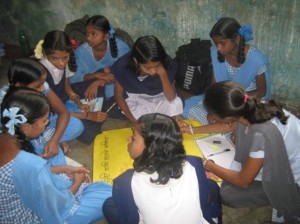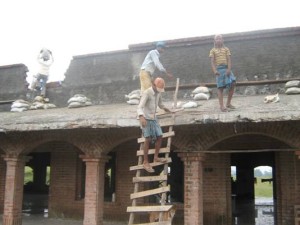Alishaba Ujagare, a school drop out from the town of Khapoli, completed her SSC with flying colours and is now pursuing Electrical Engineering from a Polytechnic College with the help of the Light of Life Trust . She is also instrumental in encouraging her siblings and neighbors to continue their studies.
Bhagyashree Wayare, daughter of a domestic help, has completed her air hostess training from Frankfinn Airhostess Institute and is now with a corporate house working as an Officer(general affairs).
Tejal Patil, who hails from Alibagh, was finding it very difficult to continue her studies but with support from the Light of Life Trust, she has successfully completed her education. Today she is a professional Auto Cad Designer and is financing an advanced course through her current job.
Reshma Gaikwad, an orphan who had lost interest in her studies, is today pursuing an advanced course in painting as she aspires to become an artist.
These are but a few stories of the impact being made by the Light of Life Trust. Located 100 kilometers outside of Mumbai, all it takes is 2.5 hour local train ride, plus a short auto ride from the station, to get to the organisation’s center in Karjat; which I was adventurous enough to do on not-too-hot Sunday in mid-February.

Setup in 2002, Light of Life Trust’s vision is to transform the lives of underprivileged rural communities. And they decided to do this by first reaching out to women and children, as they consider them to be one of the most vulnerable sections of Indian society, especially of rural India. So, one of their first moves was to set up a community center for women, a senior citizen home, a children’s home and a medical diagnostic center through Project Jagruti; and a hospice for the terminally ill with a R&D facility as well as a stress management centre through Project Aangan.
Project Jagruti also includes a vocational training center, which imparts a range of subjects – from computers, to agriculture, to vermi-culture, to cultivation of roses, to sewing, stitching, and more. The idea is to offer service-oriented jobs, which will make students vocationally independent thus ensuring them of a secure future.
Then in 2005 came Project Anando. Anando’s mission is to develop the potential of rural children. The belief behind the project is that no child shall be forced to drop out of school. In this endeavor, it is run as an afterschool programme to provide supplementary education to students who have completed their 7th standard; the focus is on personality development, life skills, the importance of education, achieving dreams and the like – subjects that would encourage children to not drop out but complete their education instead. Currently, children from 150 government and private schools attend Anando’s 34 centers.
I couldn’t help but wonder why the Trust’s efforts are targeted at children who are already getting an education? There certainly are enough children not going to school at all, whom they could have targeted instead. But it turns out that the quality of education at both government and private schools is far from satisfactory. Studies also reveal that India has the largest number of school dropout children. Between the ages of 11-18, the drop out ratio goes up to 70%. Further, with a good number of NGOs plus the government already catering to education, they thought it better to focus on higher-secondary education instead. This is why Anando’s efforts are aimed at encouraging eighth-graders to complete their education.
Private schools are essentially those that are located in remote areas and thus get little to no grants from their parent bodies. These schools are usually in places where no government school exists. Which is why the Government has simply approved their setup ( versus having to set one up themselves); but they do nothing beyond this – like fund teachers salary or electricity costs or build roads leading up to the school. Most are located in dilapidated buildings and run bare-minimum classroom setups. Teachers here come from nearby towns and earn about Rs. 1,200-1,500 per month.
Under Anando, educational materials like uniforms, books, shoes, raincoats and stationary are also given to the children. It was decided to give this material as providing the same to children is a major obstacle for their parents, thus deterring them from sending their children to school. Says Mr. Makarand, center in-charge at Karjat, “For many of the children, the two sets of uniforms they get from us is pretty much all they have to wear. They wash and wear the same two uniforms through the 365 days of the year!”

Besides education of the children themselves, the Trust also works to change the mindsets of the parents; because, not surprisingly, they face a fair amount of resistance from parents themselves. As Mr. Makarand put it, “Intervention happens at 3 levels – parents, school level (Principals) and teachers. It’s a chain reaction. The parents would never agree as a result of which the Principals of these schools shut their doors and naturally the teachers would turn a deaf ear as well.”
As part of intervention, home visits are regularly done for every child – yes, for each of the 65 children that each center educates! Initially, the visits are done once a month; once things begin to run smoothly, visits are done once in two months. With most parents being daily wage earners, the team conducts their visits early mornings or late evenings. Light of Life Trust also organizes parents’ trainings twice a year.
The process to educate the children is as thoughtful as the selection criteria itself; which first involves obtaining a list of children from the local Panchayats. Then they are assessed on a couple of factors – orphans are given priority over non-orphans, those from families with a lower income are selected over those from higher income families, only one child in a family is supported to give more families a chance to come out of poverty etc. This helps the Trust ensure that only the neediest are supported.
From 25 children in 2005, Anando has successfully reached out to over 3,000 students till date. Their social workers have been so effective that parents are now coming forward themselves to enroll their children into college through the efforts of the Trust. 250 of their children have entered college and 25 have taken admission into Industrial training institutes. It is this impact which keeps their team going!
Mr. Makarand also gave me the example of the village of Khandas, to explain the impact the organisation is making, better. In this very remote village, before the Trust’s intervention, girls did not study and boys studied only till standard eight. They now see youth from here taking up jobs in rural BPOs, some even opting for engineering. Girls, who would have otherwise been house help, now earn Rs. 7,000-8,000 a month. But what’s most important is the change in mindset that has been accomplished – when these girls become mothers, they will educate their children!
Established in 2000, Give is the largest and most trusted giving platform in India. Our community of 2.6M+ donors have supported 2,800+ nonprofits, impacting 15M+ lives across India.

Leave a Reply